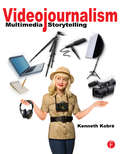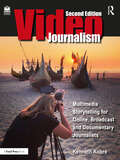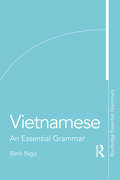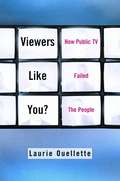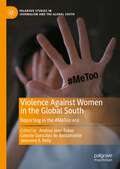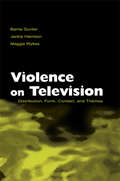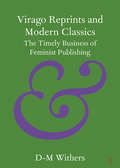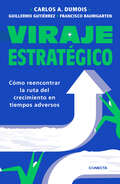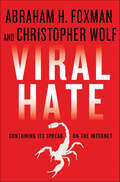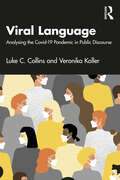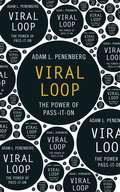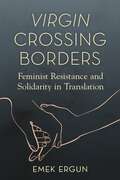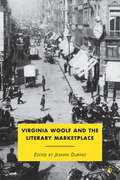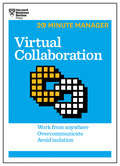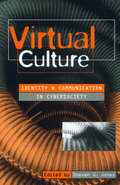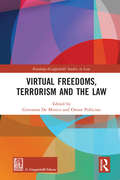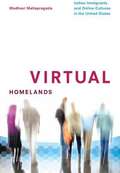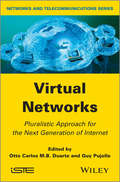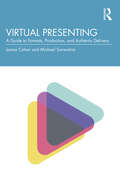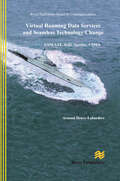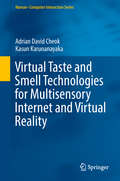- Table View
- List View
Videojournalism: Multimedia Storytelling
by Kenneth KobreVideojournalism is a new field that has grown out of traditional print photojournalism, slideshows that combine sound and pictures, public radio, documentary filmmaking and the best of television news features. This amalgam of traditions has emerged to serve the Internet's voracious appetite for video stories.Videojournalism is written for the new generation of "backpack" journalists. The solo videojournalist must find a riveting story; gain access to charismatic characters who can tell their own tales; shoot candid clips; expertly interview the players; record clear, clean sound; write a script with pizzazz; and, finally, edit the material into a piece worthy of five minutes of a viewer's attention. Videojournalism addresses all of these challenges, and more - never losing sight of the main point: telling a great story. This book, based on extensive interviews with professionals in the field, is for anyone learning how to master the art and craft of telling real short-form stories with words, sound and pictures for the Web or television. The opening chapters cover the foundations of multimedia storytelling, and the book progresses to the techniques required to shoot professional video, and record high quality sound and market the resulting product. Videojournalism also has its own website - go to just one URL and find all the stories mentioned in the book. You also will find various "how-to" videos on the site. To keep up with the latest changes in the field such as new cameras, new books, new stories or editing software, check the site regularly and "like" www.facebook.com/KobreGuide.
Videojournalism: Multimedia Storytelling for Online, Broadcast and Documentary Journalists
by Kenneth KobreVideojournalism: Multimedia Storytelling for Online, Broadcast and Documentary Journalists is an essential guide for solo video storytellers—from "backpack" videojournalists to short-form documentary makers to do-it-all broadcast reporters.Based on interviews with award-winning professionals sharing their unique experiences and knowledge, Videojournalism covers topics such as crafting and editing eye-catching short stories, recording high-quality sound, and understanding the laws and ethics of filming in public and private places. Other topics include:• understanding the difference between a story and a report• finding a theme and telling a story in a compact time frame• learning to use different cameras and lenses—from smart phones to mirrorless and digital cinema cameras• using light, both natural and artificial • understanding color and exposureThe second edition of this best-selling text has been completely revised and updated. Heavily illustrated with more than 550 photographs, the book also includes more than 200 links to outstanding examples of short-form video stories. Anatomy of a News Story, a short documentary made for the book, follows a day in the life of a solo TV videojournalist on an assignment (with a surprise ending), and helps readers translate theory to practice.This book is for anyone learning how to master the art and craft of telling real, short-form stories with words, sound, and pictures for the Web or television.A supporting companion website links to documentaries and videos, and includes additional recommendations from the field’s most prominent educators.
Vietnamese: An Essential Grammar (Routledge Essential Grammars)
by Binh NgoVietnamese: An Essential Grammar is a concise and user-friendly reference guide to modern Vietnamese. It presents a fresh and accessible description of the language in short, readable sections. Features include: Clear and up-to-date examples of modern usage. Special attention to those points which often cause problems to English-speaking learners. Vietnamese / English comparisons and contrasts highlighted throughout. The final section covers pronunciation, providing an introduction to the syllable structure of Vietnamese, and highlighting common errors made by English-speaking learners. Accompanying audio tracks for this chapter are available at www.routledge.com/9781138210707. Vietnamese: An Essential Grammar is ideal for learners involved in independent study and for students in schools, colleges, universities and adult classes of all types.
Viewers Like You: How Public TV Failed the People
by Laurie OuelletteHow "public" is public television if only a small percentage of the American people tune in on a regular basis? When public television addresses "viewers like you," just who are you? Despite the current of frustration with commercial television that runs through American life, most TV viewers bypass the redemptive "oasis of the wasteland" represented by PBS and turn to the sitcoms, soap operas, music videos, game shows, weekly dramas, and popular news programs produced by the culture industries. Viewers Like You? traces the history of public broadcasting in the United States, questions its priorities, and argues that public TV's tendency to reject popular culture has undermined its capacity to serve the people it claims to represent. Drawing from archival research and cultural theory, the book shows that public television's perception of what the public needs is constrained by unquestioned cultural assumptions rooted in the politics of class, gender, and race.
Vinnie the Dove: Targeting the v Sound (Speech Bubbles 2)
by Melissa PalmerVinnie loves to dive in water, but it always makes him so cold! Join him on his mission to find a way to finally get warmed up. This picture book targets the /v/ sound and is part of Speech Bubbles 2, a series of picture books that target specific speech sounds within the story. The series can be used for children receiving speech therapy, for children who have a speech sound delay/disorder, or simply as an activity for children’s speech sound development and/or phonological awareness. They are ideal for use by parents, teachers or caregivers. Bright pictures and a fun story create an engaging activity perfect for sound awareness. Picture books are sold individually, or in a pack. There are currently two packs available – Speech Bubbles 1 and Speech Bubbles 2. Please see further titles in the series for stories targeting other speech sounds.
Violence Against Women in the Global South: Reporting in the #MeToo era (Palgrave Studies in Journalism and the Global South)
by Andrea Jean Baker Celeste González de Bustamante Jeannine E. RellyBringing together 14 journalism scholars from around the world, this edited collection addresses the deficit of coverage of violence against women in the Global South by examining the role of the legacy press and social media that report on and highlight ways to improve reporting. Authors investigate the ontological limitations which present structural and systemic challenges for journalists who report on the normalization of violence against women in country cases in Argentina; Brazil; Mexico; Indonesia; Kenya, Nigeria, South Africa; Egypt; Libya, Syria, and Yemen. Challenges include patriarchal forces; gender imbalance in newsrooms; propaganda and censorship strategies by repressive, hyper-masculine, and populist political regimes; economic and digital inequities; and civil and transnational wars. Presenting diverse conceptual, methodological, and empirical chapters, the collection offers a revision of existing frameworks and guidelines and aims to promote more gender-sensitive, trauma-informed, solutions-driven, and victim or survivor centered reporting in the region.
Violence on Television: Distribution, Form, Context, and Themes (Routledge Communication Series)
by Barrie Gunter Maggie Wykes Jackie HarrisonConcern about violence on television has been publicly debated for the past 50 years. TV violence has repeatedly been identified as a significant causal agent in relation to the prevalence of crime and violence in society. Critics have accused the medium of presenting excessive quantities of violence, to the point where it is virtually impossible for viewers to avoid it. This book presents the findings of the largest British study of violence on TV ever undertaken, funded by the broadcasting industry. The study was carried out at the same time as similar industry-sponsored research was being conducted in the United States, and one chapter compares findings from Britain and the U.S.A. The book concludes that it is misleading to accuse all broadcasters of presenting excessive quantities of violence in their schedules. This does not deny that problematic portrayals were found. But the most gory, horrific and graphic scenes of violence were generally contained within broadcasts available on a subscription basis or in programs shown at times when few children were expected to be watching. This factual analysis proves that broadcasters were meeting their obligations under their national regulatory codes of practice.
Violent Inheritance: Sexuality, Land, and Energy in Making the North American West (Environmental Communication, Power, and Culture #3)
by E CramViolent Inheritance deepens the analysis of settler colonialism's endurance in the North American West and how infrastructures that ground sexual modernity are both reproduced and challenged by publics who have inherited them. E Cram redefines sexual modernity through extractivism, wherein sexuality functions to extract value from life including land, air, minerals, and bodies. Analyzing struggles over memory cultures through the region's land use controversies at the turn of and well into the twentieth century, Cram unpacks the consequences of western settlement and the energy regimes that fueled it. Transfusing queer eco-criticism with archival and ethnographic research, Cram reconstructs the linkages—"land lines"—between infrastructure, violence, sexuality, and energy and shows how racialized sexual knowledges cultivated settler colonial cultures of both innervation and enervation. From the residential school system to elite health seekers desiring the "electric" climates of the Rocky Mountains to the wartime incarceration of Japanese Americans, Cram demonstrates how the environment promised to some individuals access to vital energy and to others the exhaustion of populations through state violence and racial capitalism. Grappling with these land lines, Cram insists, helps interrogate regimes of value and build otherwise unrealized connections between queer studies and the environmental and energy humanities.
Virago Reprints and Modern Classics: The Timely Business of Feminist Publishing (Elements in Publishing and Book Culture)
by D-M WithersReprinting, republishing and re-covering old books in new clothes is an established publishing practice. How are books that have fallen out of taste and favour resituated by publishers, and recognised by readers, as relevant and timely? This Element outlines three historical textures within British culture of the late 1970s and early 1980s – History, Remembrance and Heritage – that enabled Virago's reprint publishing to become a commercial and cultural success. With detailed archival case studies of the Virago Reprint Library, Testament of Youth and the Virago Modern Classics, it elaborates how reprints were profitable for the publisher and moved Virago's books - and the Virago brand name - from the periphery of culture to the centre. Throughout Virago's reprint publishing - and especially with the Modern Classics - the epistemic revelation that women writers were forgotten and could, therefore, be rediscovered, was repeated, again and again, and made culturally productive through the marketplace.
Viraje estratégico: cómo reencontrar la ruta del crecimiento en tiempos adversos
by Guillermo Gutiérrez Carlos A. Dumois Francisco BaumgartenUNA METODOLOGÍA DE CAMBIO ESTRATÉGICO PARA EMPRESAS QUE VIVEN TIEMPOS DIFÍCILES. Las empresas hoy en día se encuentran en alto riesgo: la incertidumbre económica, el desenfoque de sus negocios, la tolerancia a resultados mediocres y la falta de liderazgo las hacen más susceptibles a las crisis. En Viraje estratégico los consultores internacionales Carlos, Guillermo y Francisco comparten un método propio basado en la cultura corporativa latinoamericana y probado en cientos de empresas familiares que superaron sus dificultades y encontraron un nuevo camino de crecimiento y sostenibilidad. Al mejor estilo de experimentados navegantes, analizan las vías de rescate cuando los negocios se estancan o están cerca del naufragio. Su misión es facilitar la comprensión de esas dificultades e impulsar a los líderes empresarialesa rescatar su capacidad de creación de valor. Además, ilustran cada etapa del proceso con siete emblemáticos casos reales de viraje. Enfrenta las tormentas organizacionales y aprende a convertirlas en grandes oportunidades de cambio que no solo salven a tu empresa de la quiebra, sino que reconstruyan su viabilidad hacia el futuro.
Viral Hate: Containing Its Spread on the Internet
by Christopher Wolf Abraham H. FoxmanEmboldened by anonymity, individuals and organizations from both left and right are freely spewing hateful vitriol on the Internet without worrying about repercussions.Lies, bullying, conspiracy theories, bigoted and racist rants, and calls for violence targeting the most vulnerable circulate openly on the web.And thanks to the guarantees of the First Amendment and the borderless nature of the Internet,governing bodies are largely helpless to control this massive assault on human dignity and safety. Abe Foxman and Christopher Wolf expose the threat that this unregulated flow of bigotry poses to the world.They explore how social media companies like Facebook and YouTube, as well as search engine giant Google, are struggling to reconcile the demands of business with freedom of speech and the disturbing threat posed by today's purveyors of hate. And they explain the best tools available to citizens, parents, educators, law enforcement officers, and policy makers toprotect thetwin values of transparency and responsibility. As Foxman and Wolf show, only an aroused and engaged citizenry can stop the hate contagion before it spirals out of control - with potentially disastrous results.
Viral Language: Analysing the Covid-19 Pandemic in Public Discourse
by Veronika Koller Luke C. CollinsViral Language considers a range of different types of public communication and their discussion of the Covid-19 pandemic as a way to investigate health communication. The authors introduce and apply a range of approaches informed by linguistic theory to investigate experiences of the pandemic across a variety of public contexts. In doing so, they demonstrate how experiences of health and illness can be shaped by political messaging, scientific research, news articles and advertising. Through a series of case studies of Covid-related texts, the authors consider aspects of language instruction, information and innovation, showcasing the breadth of topics that can be studied as part of health communication. Furthermore, each case study provides practical guidance on how to carry out investigations using social media texts, how to analyse metaphor, how to track language innovation and how to work with text and images. Viral Language is critical reading for postgraduate and upper undergraduate students of applied linguistics and health communication.
Viral Loop: The Power Of Pass-it-on
by Adam PenenbergYou read a book, you recommend it to a friend. That friend tells another friend. And another... until the book becomes this year's word-of-mouth sensation. This is the first to analyze the power of the 'pass-it-on' phenomenon, introducing us to the architects of the mightily efficient, money-spinning model known as the Viral Loop - the secret behind some of the most successful businesses in recent history. Outfits such as Google, eBay, Flickr and Facebook all employ the model at their core; all have seen their stock valuations skyrocket within years of forming. The genius lies in the model's reliance on replication: what's the point of using Facebook if none of your friends can see your profile, or using Flickr if you can't share your photos? Where's the joy in posting a video on YouTube if no one watches it? In creating a viral product that people want, need and desire, growth can, and will, take care of itself. Find out why the Loop will catch us all up, sooner rather than later...
Virgin Crossing Borders: Feminist Resistance and Solidarity in Translation (Transformations: Womanist studies)
by Emek ErgunThe Turkish-language release of Hanne Blank’s Virgin: The Untouched History is a politically engaged translation aimed at disrupting Turkey’s heteropatriarchal virginity codes. In Virgin Crossing Borders, Emek Ergun maps how she crafted her rendering of the text and draws on her experience and the book’s impact to investigate the interventionist power of feminist translation. Ergun’s comparative framework reveals translation’s potential to facilitate cross-border flows of feminist theories, empower feminist interventions, connect feminist activists across differences and divides, and forge transnational feminist solidarities. As she considers hopeful and woeful pictures of border crossings, Ergun invites readers to revise their views of translation’s role in transnational feminism and examine their own potential as ethically and politically responsible agents willing to search for new meanings. Sophisticated and compelling, Virgin Crossing Borders reveals translation’s vital role in exchanges of feminist theories, stories, and knowledge.
Virginia Woolf and the Literary Marketplace
by Jeanne DubinoThese unique essays focus primarily on Woolf's non-fiction and considers her in the context of the modernist marketplace. With research based on new archival material, this volume makes important new contributions to the study of the 'gift economy. '
Virginia Woolf and the Migrations of Language
by Emily DalgarnoVirginia Woolf's rich and imaginative use of language was partly a result of her keen interest in foreign literatures and languages - mainly Greek and French, but also Russian, German and Italian. As a translator she naturally addressed herself both to contemporary standards of translation within the university, but also to readers like herself. In Three Guineas she ranged herself among German scholars who used Antigone to critique European politics of the 1930s. Orlando outwits the censors with a strategy that focuses on Proust's untranslatable word. The Waves and The Years show her looking ahead to the problems of postcolonial society, where translation crosses borders. In this first in-depth study of Woolf and European languages and literatures, Emily Dalgarno opens up a rewarding new way of reading her prose.
Virginia Woolf, Literary Materiality, and Feminist Aesthetics: From Pen to Print (Material Modernisms)
by Amber JenkinsThis book interrogates the relationship between the material conditions of Woolf's writing practices and her work as a printer and publisher at the Hogarth Press. In bringing to light her embodied literary processes, from drafting and composition to hand-printing and binding, this study foregrounds the interactions between Woolf's modernist experimentation and the visual and material aspects of her printed works. By drawing on the field of print culture, as well as the materialist turn in Woolf scholarship, it explores how her experience in print, book-design and publishing underlines her experimental writing, and how her literary texts are conditioned by the context of their production. This book, therefore, provides new ways of reading Woolf's modernism in the context of twentieth-century print, material, and visual cultures. By suggesting that Woolf's work at the Hogarth Press sensitized her to the significant role the visual aspects of a text play in its system of representation, it also considers the extent to which materiality informs both her work, as well as her engagement with Bloomsbury formalist aesthetics, which often exaggerate the distinction between visual and verbal modes of expression.
Virtual Collaboration (HBR 20-Minute Manager Series)
by Harvard Business ReviewWorking remotely gives you flexibility and independence. But it can pose challenges when you need to team up with colleagues or coworkers. Virtual Collaboration covers the basics of working productively-and collaboratively-from anywhere. You'll learn to: Communicate clearly over a variety of media Bond with colleagues across the wires Keep others-and yourself-accountable Avoid and mitigate tech glitchesDon't have much time? Get up to speed fast on the most essential business skills with HBR's 20-Minute Manager series. Whether you need a crash course or a brief refresher, each book in the series is a concise, practical primer that will help you brush up on a key management topic. Advice you can quickly read and apply, for ambitious professionals and aspiring executives-from the most trusted source in business. Also available as an ebook.
Virtual Culture: Identity and Communication in Cybersociety
by Steven JonesVirtual Culture marks a significant intervention in the current debate about access and control in cybersociety exposing the ways in which the Internet and other computer-mediated communication technologies are being used by disadvantaged and marginal groups - such as gay men, women, fan communities and the homeless - for social and political change. The contributors to this book apply a range of theoretical perspecitves derived from communication studies, sociology and anthropology to demonstrate the theoretical and practical possibilities for cybersociety as an identity-structured space.
Virtual Freedoms, Terrorism and the Law (Routledge-Giappichelli Studies in Law)
by Giovanna De MinicoThis book examines the risks to freedom of expression, particularly in relation to the internet, as a result of regulation introduced in response to terrorist threats. The work explores the challenges of maintaining security in the fight against traditional terrorism while protecting fundamental freedoms, particularly online freedom of expression. The topics discussed include the clash between freedom of speech and national security; the multijurisdictional nature of the internet and the implications for national sovereignty and transnational legal structures; how to determine legitimate and illegitimate association online; and the implications for privacy and data protection. The book presents a theoretical analysis combined with empirical research to demonstrate the difficulty of combatting internet use by terror organizations or individuals and the range of remedies that might be drawn from national and international law. The work will be essential reading for students, researchers and policy makers in the areas of Constitutional law; Criminal Law, European and International law, Information and Technology law and Security Studies.
Virtual Homelands: Indian Immigrants and Online Cultures in the United States
by Madhavi MallapragadaThe internet has transformed the idea of home for Indians and Indian Americans. In Virtual Homelands: Indian Immigrants and Online Cultures in the United States, Madhavi Mallapragada analyzes home pages and other online communities organized by diasporic and immigrant Indians from the late 1990s through the social media period. Engaging the shifting aspects of belonging, immigrant politics, and cultural citizenship by linking the home page, household, and homeland as key sites, Mallapragada illuminates the contours of belonging and reveals how Indian American struggles over it trace back to the web's active mediation in representing, negotiating, and reimagining "home." As Mallapragada shows, ideologies around family and citizenship shift to fit the transnational contexts of the online world and immigration. At the same time, the tactical use of the home page to make gender, racial, and class struggles visible and create new modes for belonging implicates the web within complex political and cultural terrain. On e-commerce, community, and activist sites, the recasting of home and homeland online points to intrusion by public agents such as the state, the law, and immigration systems in the domestic, the private, and the familial. Mallapragada reveals that the home page may mobilize to reproduce conservative narratives of Indian immigrants' familial and citizenship cultures, but the reach of a website extends beyond the textual and discursive to encompass the institutions shaping it, as the web unmakes and remakes ideas of "India" and "America."
Virtual Networks: Pluralistic Approach for the Next Generation of Internet
by Guy Pujolle Otto Carlos M.B. DuarteThe first chapter of this title concerns virtualization techniques that allow sharing computational resources basically, slicing a real computational environment into virtual computational environments that are isolated from one another. The Xen and OpenFlow virtualization platforms are then presented in Chapter 2 and a performance analysis of both is provided. This chapter also defines the primitives that the network virtualization infrastructure must provide for allowing the piloting plane to manage virtual network elements. Following this, interfaces for system management of the two platforms are proposed in Chapter 3. To control and manage virtual network elements, five primitives that the network virtualization infrastructure must provide are defined: instantiate, delete, migrate, monitor and set. The book then moves on to survey existing control algorithms for virtual networking. It also describes the main challenges for packet forwarding using Xen as a virtualization tool and describes, in more detail, a proposal for local control of virtual networks. Within each physical node, this proposal guarantees the service level acquired by each virtual network, even in the presence of misbehaving virtual networks. Contents 1. Virtualization, Luís Henrique M.K. Costa. 2. Virtual Network Interfaces, Miguel Elias M. Campista. 3. Performance Improvement and Control of Virtual Network Elements, Igor M. Moraes. 4. State of the Art in Context-Aware Technologies, Edmundo R.M. Madeira and Guy Pujolle. 5. Providing Isolation and Quality-of-Service to Virtual Networks, Miguel Elias M. Campista. 6. Piloting System, Edmundo R.M. Madeira and Nelson Luis S. Da Fonseca. 7. Management and Control: The Situated View, Otto Carlos M.B. Duarte. 8. System Architecture Design, Otto Carlos M.B. Duarte. About the Authors Otto Carlos M.B. Duarte is Full Professor at Universidade Federal do Rio de Janeiro in Brazil, where he has worked since 1978. His research interests include mobile communications, security, multicast, and QoS guarantees. Guy Pujolle is currently Professor at University Pierre and Marie Curie (Paris VI) in France and a member of the Scientific Advisory Board of Orange/France Telecom Group. He has published widely in the area of computer systems modeling and performance, queuing theory, high-speed networks, intelligence in networking, wireless networks, and Post-IP networks, including 19 influential texts and monographs in these areas.
Virtual Presenting: A Guide to Formats, Production and Authentic Delivery
by Jamie Cohen Michael SorrentinoResponding to the widespread and continued acceleration of virtual working practices in recent years, Virtual Presenting provides a clear guide to producing, presenting, and broadcasting in a remote context. Unlike traditional studio production where a presenter is surrounded by a crew and cameras, the virtual presenter is often isolated or connected to a remote crew. Virtual Presenting explains how to make an authentic connection across great spaces, linked only via the Internet. Topics covered include how to build a virtual setup; how to appear on camera; how to appear confident and comfortable; and how to optimize your presentation voice. The authors demonstrate how to tell effective stories across the entire new media landscape of webcasting, webinars, livestreams, and virtual events. Finally, success stories and case studies from teachers, students, and professionals are interwoven to show how these guidelines translate into best practices. Virtual Presenting will be a valuable resource for students of media production and remote broadcasting as well as professionals looking to become stronger communicators and visual presenters.
Virtual Roaming Data Services and Seamless Technology Change: GSM, LTE, WiFi, Satellite, CDMA
by Arnaud Henry-LabordèreThe subject is “Virtual Roaming for data services” and “Seamless Technology change” also called “Number Continuity”.“Virtual Roaming for voice and SMS” was covered in one of the author's previous book. “Virtual Roaming” means that it allows a subscriber to visit a network which his home network does not have an agreement with. The “Seamless Technology change” allows a user to keep all his services including reception of calls and SMS sent to his usual number when he switches his GSM to a Satellite phone or to WiFi. The implementation of Seamless Technology change uses the SS7 Roaming Hub and GTP Hubs technology explained in the first part of the book. The book also contains chapters explaining in detail the steering and anti-steering of roaming, LTE Serving Mobile Location Centers, and Advanced Policy and Charging implementations in LTE and 3G. This is to be used as an easy reference book. All the relevant references to the standards are included chapter by chapter. This is the first book on the two main subjects of Virtual Data Roaming and Seamless Technology change. Keywords:Virtual Roaming, Number Continuity, Seamless technology change, Policy Charging and Control, LTE LBS, Steering of Roaming, GTP Hub, MMS Hub,RADIUS Hub, DIAMETER Hub
Virtual Taste and Smell Technologies for Multisensory Internet and Virtual Reality
by Adrian David Cheok Kasun KarunanayakaCurrently, Internet and virtual reality communication is essentially audio-visual. The next important breakthrough of the Internet will be the communication and sharing of smell and taste experiences digitally. Audio-visual stimuli are frequency based, and they can be easily digitized and actuated. On the other hand, taste and smell stimuli are based on chemical molecules, therefore, they are not easy to digitize or actuate. To solve this problem, we are required to discover new digital actuation technologies for taste and smell. The authors of this book have experimented on developing digital actuation devices for several years. This book will provide a complete overview of the importance of digitizing taste and smell, prior works, proposed technologies by the authors, other state of the art research, advantages and limitations of the proposed methods, and future applications. We expect digital taste and smell technologies will revolutionize the field of multisensory augmented reality and open up new interaction possibilities in different disciplines such as Human Computer Interaction, Communication, and Augmented and Virtual Reality.
